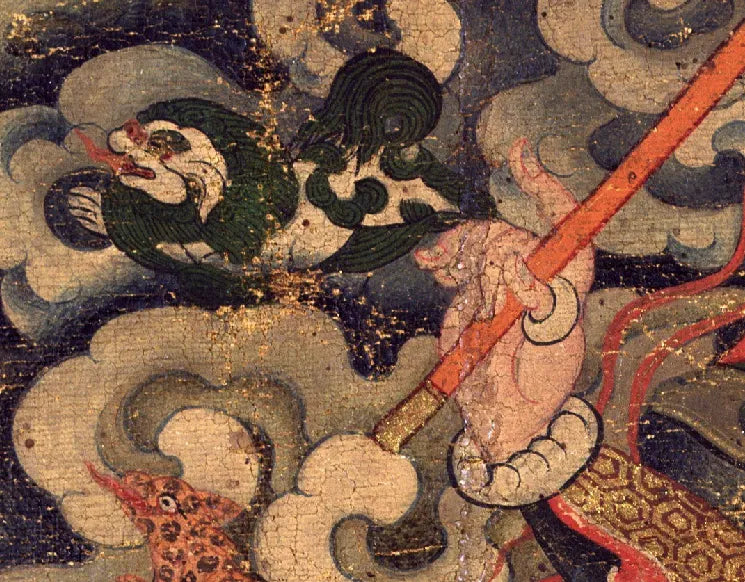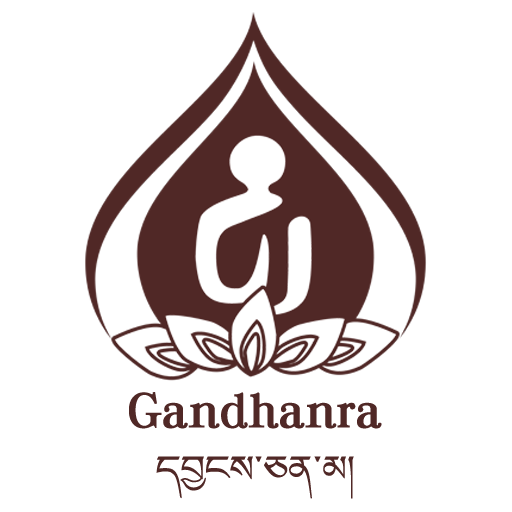
Ring of the Tibetan

"A set of women's ornaments from the Shigatse region"
late 19th century, V&A Museum collection
Exquisite ornaments acquired cheaply during the British invasion of Tibet
*Two saddle-shaped rings below (both set with coral)

The silver inlaid coral saddle ring in the picture
Some domestic and foreign craftsmen suggested to me
The carved patterns on the ring may correspond to the pads on the saddle
The raised ring face represents the supply treasure or the three supportings.

At the end of the 11th century, a private collection
Subject: King Songtsen Gampo and his two consorts, Nechen
The Zamp threw off the ring and said, "Wherever it falls, that is where we shall build." The ring landed in the lake.
Note: There are also claims that the ring belonged to Princess Chutzun.

"Men's Copper Ring with Inlaid Turquoise"
Early 20th century, in the collection of the British Museum

"Gold horse-shaped pendant, gold earrings, and gold ring"
Artifacts unearthed from the previous dynasty in Langkazi County
Among them, the gold rings are found in large quantities
These rings are made of gold wires wrapped around a gold disc and gold pieces.
When people mention the origin history of the Jokhang Temple, they will often mention the precious ring used for addressing, which was worn by Songtsen Gampo. There has been much debate among classical scholars about the exact form of the ring. A popular belief is that the ring was set with a celestial bead, a theory that has been circulating since the 17th century. In various classics related to the early history of Tibetan Buddhism, there is often mention of a nine-eyed finger sleeve or ring woven from black and white wool. The nine-eyed pattern on the sleeve/ring is associated with prosperity and good fortune. To this day, such ornaments are still found in some agricultural and pastoral areas of Tibet. Similarly, another historical figure associated with the Jokhang Temple is the revered architect and restorer of buildings in Lhasa, Thonmi Sambhota (བརྩོན་འགྲུས་གྲགས་པ་; 1123-1193). Before his passing, Thonmi Sambhota wove over a dozen rings made of bamboo strips, which he distributed to his disciples, admonishing them to uphold their commitments to their teacher and to Buddha.

"The Twelve-armed Red Body Mandala of the Sakya Tradition"
Mid-15th century, Private Collection
 Partial close-up of the image: Set of rings worn on the main hand (combination decoration)
Partial close-up of the image: Set of rings worn on the main hand (combination decoration)

"Silver Lucky Patterned Ornament Engraved Qiong Oracle Ring"
From the early 19th century, stored in the NYTH Museum.

Late 19th century, private collection
It is generally believed that such rings are related to the protector deity/hidden treasure tradition
The ring is decorated with coiled snakes and a red skull
The top of the ring features a large black gem (oil-coated gemstone/obsidian)
Based on archaeological findings and folklore, in addition to metal rings, the materials used to make rings in early Tibetan culture included bone (as recorded in British documents), rattan, and sheep wool. By the period of the Tibetan Empire, metal rings in Tibet had become more sophisticated, with various shapes such as circular, square, circular-square half-clasp, and gem-decorated ring faces. With the introduction of Buddhism to Tibet, the decorative system of South Asia began to influence Tibetan culture, leading to a diverse interpretation of rings. In Tibetan language, rings are commonly referred to as "sor gdub"(སོར་གདུབ་) or "sor rgyan."(སོར་རྒྱན་). Informal terms for rings include "mdzub dkaris" (མཛུབ་དཀྲིས་) or "mdzub rgyus." (མཛུབ་རྒྱུས་). All finger ornaments, including rings, can be referred to as "tshigs khebs." (ཚིགས་ཁེབས་). Finger guards used by warriors for archery are called "kred kor"(ཀྲད་ཀོར་) or "mthemb kor."(མཐེབ་ཀོར་) In the Kham region (collected in the Dege region), there is a saying: "A man's finger guard can serve the war god, a woman's ring can serve the heavenly goddess." It is important to note that in addition to indicating status and serving as daily decorations, Tibetan rings also serve as personal talismans and tools for spiritual practice. High priests use divination rings, and hidden treasure discoverers use revelation rings. Rings help them connect with divine spirits and seek out hidden treasures within the world.

Mid-19th century, in the collection of the NYTH Museum.


A set of jewelry from Lhasa region: rings and some earrings
Mid-18th century, European private collection

"A series of copper rings with different designs, dating back to the late 18th century, found in the collection of the NYTH Museum. They still bear remnants of precious gems such as coral and turquoise on the surface."
- Vajra-shaped ring with two ends on the ring face (རྡོ་རྗེའི་སོར་གདུབ་)
- Lotus petal ring with granular ring face decoration (པད་སྤུངས་ཅན་)
- Half-closed gem-set ring with eyes (སོར་གདུབ་མིག་ཅན་)
- Circular iron ring without gems (གནམ་ལྕགས་ཚིགས་ཁེབས་)
It should be noted that not all rings are used as finger decorations. In traditional ornaments, there are ring head ornaments and ring-shaped buckles (with various decorative carvings like phoenix birds and floral patterns). Additionally, they are sometimes classified into seven categories by region:
- Nepalese rings, Indian rings, Mongolian rings, Bhutanese rings, Tibetan rings, Kham rings, and Amdo rings.

Please note the two different styles of precious silver rings below.
The ring between sacred and secular.
This article is translated from Sorang Wangqing's blog.

1 comment
addr5l